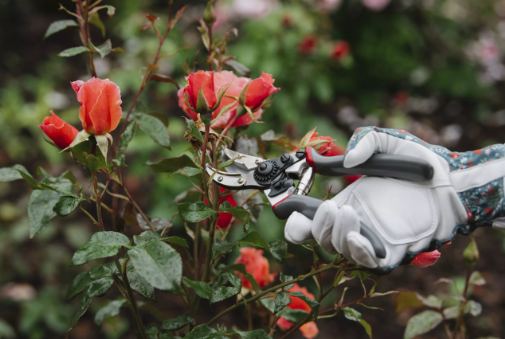Ground cover plants are naturally low-growing plants that cover the soil with attractive foliage or flowers or a combination of both and help create a low maintenance and somewhat weed free area in your garden. They usually cover the ground quite quickly, covering bare soil and can be deciduous or evergreen. Ground cover plants are great at suppressing weeds, which means less need for weed killers and less work in maintaining the beds and trying to keep on top of the weeds. They can help to lock in soil moisture and nutrients which means you’ll need to be using less fertilizer and less watering and some can even help with soil erosion on slopes, their roots holding everything together when it rains.
You can use ground cover plants to cover or fill in gaps at the front of the beds or in difficult to plant areas like slopes and banks or places where it’s difficult to reach or you just want a low maintenance area in part of your garden that’s easy to mind and gives lots of colour. Before planting any ground cover plants make sure you weed the area well, getting rid of grass and weeds as these will be difficult to get rid of once the plants are in place. A few easy to grow options and some of my own favorites include;
Carpet Roses, these are a fantastic range of plants to grow, they come in a range of colours - pinks, reds, yellows, whites, and oranges - they flower from Summer through to December and are very low maintenance - no needs for spraying, just cut them back in February and give them a feed and they’ll look after themselves. Great for covering slopes or banks or in mixed borders and give an excellent display. Plant in a sunny, sheltered spot with good drainage. They’ll grow about 2 or 2.5 feet tall and with a 3 foot spread. Anyone who grows these will sing their praises, so if you’ve yet to grow them they are well worth growing, whether for ground cover or just as a beautiful flowering shrub.
My next choice are Hardy Geraniums not to be mixed up with pelargoniums, the “geraniums” we put in window boxes and hanging baskets. Hardy Geraniums are low growing and quick to establish herbaceous perennials that will grow almost anywhere, except in wet soil. Sometimes known as Cranesbill Geranium they are a very versatile plant growing in sun or shade and suited to most styles of gardens be it cottage style gardens or contemporary gardens. They can look particularly well planted under roses and shrubs. They range in colours from blues and pinks, and although they lose their leaves they flower from late Spring to early Autumn, and are also great for attracting butterflies and bees. They’ll grow to a height of about 2 foot and spread about 3 feet, “Rozanne” is an excellent, award winning variety, with violet, blue flowers that’s definitely worth growing - give this one a good cut back when the flowers start to fade in late Autumn and Johnston Blue is a tried and trusted variety.
Aubretia are a wonderful sign that Spring has arrived, ranging in colours from white, pinks, reds and most popular shades of blue and purple. They thrive on well drained conditions and do well in alkaline soils in full sun. They are ideal for growing along the top of walls, where they can spill over the edge, or on stony or sloped areas. They are also great for gravel gardens and rockeries. Cut back after flowering and you’ll most likely get a second flush of flowers. It grows well in sunny spots but can grow in semi shade and is quite drought tolerant. To keep it compact, cut it back lightly around late May or June. If they get out of hand you can cut them back quite hard, water well and they’ll come back nice and bushy and compact. They spread out a little over a foot maybe 14 - 16 inches and grow about 8 or 9 inches in height.
Helianthemums or Rock Roses are a great ground cover for sunny locations. They come in a wide range of colours and produce loads of flowers, reds, yellow, oranges white & pink. They are hardy, low, spreading bushes that flower in late spring/early summer. Give the faded flowers a light trim to keep them neat and compact and once they have good drainage and a sunny spot they are easy to grow and very low maintenance. Helianthemums are evergreen or semi evergreen, they may lose leaves in a hard winter or exposed position but soon recover in Spring. They’ll grow about a foot tall and a foot and a half of a spread, and easy to grow low maintenance.
Some other popular ground cover plants include Vinca, or Perrywinkle - a fast growing evergreen - which can take over a bit - with blue to purple flowers - will grow anywhere really.
Creeping herbs can be a good option, thyme, spreading rosemary or in a shady spot, try sweet woodruff - good under trees - with nice star shaped white flowers. Sowing a patch with wildflower mixes can be a nice option to cover ground - there are lots of different wildflower mixes available with choices in size, colour and suitable locations.
Lavender can be a beautiful choice for ground cover, good for a front of a border, planting under roses, lining a path, or for covering a sunny area. The English lavenders tend to be a tougher variety - Hidcote and Munstead are 2 good varieties - give them plenty of good drainage and cut back lightly after flowering - just over a foot in height and about a foot and a half spread.
Bergenia (elephant’s ears) are tough plants that make good ground cover. Heathers are great ground cover - excellent for bees - winter and spring flowering varieties are easiest for growing and Ferns can be a good choice for damp and shaded areas.
Remember, before planting any ground cover plants make sure you weed the area well, getting rid of grass and weeds.
A few jobs for the week ahead;
- Watch for slug and snail damage to emerging shoots of perennial flowers, apply some organic slug pellets or spray with Grazers for slugs and snails as a preventive
- Plant up Summer flowering bulbs in pots - Dahlias, Lilies and Begonias - all great for long lasting Summer Colour - cost effective and easy to grow
- Feed fruit trees and bushes by sprinkling sulphate of potash or Osmo Pro Bloom fertiliser around the base to encourage fruiting.
- Roses can be cut back and then tidy around the base and give a handful of feed or mulch with manure
- Apply some liquid moss treatment on the lawn and follow with some granulated feed & weed and a shake of lawn seed to improve the lawn get it set for the season ahead
- Seed potatoes can be Chitted or sprouted at this time of year - this is done in light, frost free conditions and will help give an earlier harvest and a bigger yield - line them up on a seed tray or an egg carton to keep them in position

